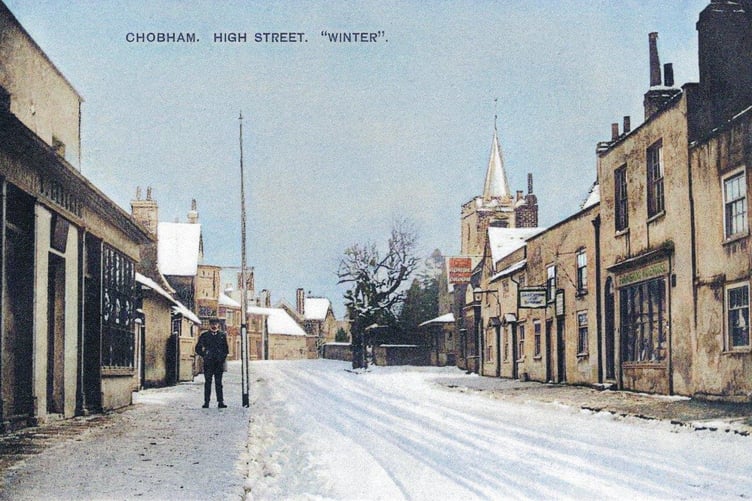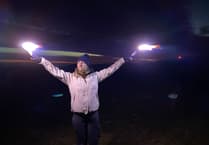I am sure that many of us have been saying “Christmas is not like it used to be”.
Our forebears probably said the same thing. And, of course, times have always changed.
Take the lovely picture postcard, from the 1900s, that is reproduced here.
From Peeps researcher Mark Coxhead’s collection, it shows a snowy scene in Chobham. However, it is a fake. Well, of sorts.
The original image was monochrome but this view was coloured artificially to make it look wintry. It was most likely issued around Christmas.
It is difficult to tell whether there really was snow in Chobham when the photographer took the picture – or whether, in the process of developing or printing the image, some “snow” was added in the road and on the pavements.
Christmas is a time of traditions. And it has certainly changed over the centuries.
St Thomas’ Day – December 21, the shortest day of the year – was when people once went gooding.
To go “a-gooding” was a custom in which the poor folk visited the houses of the wealthy for the “dole” – the distribution of money, food or clothing.
Esteemed historian Matthew Alexander wrote in his book Folklore of Surrey that in Byfleet the “gooders” called at the “best houses” collecting money, which was afterwards divided equally among those who did the round.
At Puttenham, Daniel Simmonds distributed to each person a gallon of rye, which was ground for the folk by a Mrs Valler of Cutt Mill. Some of the people then made pancakes from it.
Bread was given at Thames Ditton, Godstone and Farnham. The poor from Worplesdon received beer – and at Dorking, beef was distributed.
In 1789, Henry Austin, lord of the manor of Shalford, paid 6d each to no fewer than 47 “dames” who came “a-gooding”.
Gooding was eventually increasingly discouraged “by the higher powers in the place” – in other words, those who lived in the big houses.
Money that was still being given out became less and less each year, until it was not worth the trouble for the poor to continue the custom.
In centuries long ago, it was mostly the church that helped and supported the poor.
This was later replaced by a tax that was paid to the poor by those who were better off.
However, everything changed in 1834 with the introduction of the Poor Law Amendment Act, which forced a number of parishes close to one another to form a union and build a large workhouse. Two of Woking’s parishes were part of the Guildford Union.
Those poor souls from the Woking area who were destitute had to go into the workhouse at Guildford.
Life in a workhouse was a little better on Christmas Day, as The West Surrey Times of December 29, 1888 reported.
It said: “The day began with the workhouse chaplain conducting divine service in the chapel.
“Dinner of course was the great event of the festivities, this being the only day throughout the whole year when the inmates have the opportunity of seeing the savoury joints of meat cut up in their presence.”
At one time, butchers and poulterers hung their produce on the front of their shops every day.
As Christmas approached and people began to choose the bird of their choice for their festive table, those displays became more and more elaborate, as butchers competed with one another.
In the past, Advent was a time of fasting in preparation for the feast to come.
However, in the week before Christmas, groups of musicians would go round, door to door, playing and singing a much wider repertoire of carols than today, with different tunes according to different regions.
Wassaling, from the ancient Saxon toast “waes hael” (“be healthy”), was a distinctive Christmas custom.
Going door to door, and expecting some food or money, the wassailers would sing to wish the household good luck for the coming year.
In cider-making areas, wassailers still wassail the cider-apple trees.
Soon after the start of the First World War in August 1914, it was being said that the conflict would be “all over by Christmas”.
How wrong they were. But on the Home Front, the first Christmas of the war was much the same as before, with the same celebrations of the birth of Jesus and all the other traditions of the festive season.
But Christmas shopping for children included buying military-themed gifts such as toy soldiers, toy guns and little uniforms.
Among adults, the enthusiasm for the giving of Christmas gifts was as strong as ever. But the moral consensus was to avoid frivolity.
For those away on active service, gifts included warm gloves, safety razors, watches, lighters and cigarettes.
In times gone by, the start of Christmas was Christmas Day – and it continued on the 12 days that followed.
Farm work was then kept to a minimum and Twelfth Night was the climax of the Christmas holiday. The centrepiece of the night’s celebration was the Twelfth cake.
Coming together and enjoying good company, good food and drink and a time to rest was just the same in olden days as it is now.
But it was probably less complicated and certainly less frenetic than it is for many people today.




Comments
This article has no comments yet. Be the first to leave a comment.